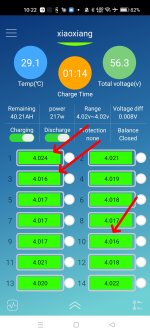Hello, this is a Chamrider 52v37.7ah 14s13p battery with 18650 Samsung cells running a BBSHD.
I noticed in the Bluetooth BMS that group 1 at rest often has 0.01V difference from the other groups.
And as you can see in the video, group 1 has significantly more voltage sag than the other groups.
Is there any reason for concern? The battery is about 1 year and 4 months old, approximately 20000km.
I don't have any issues with the battery and everything works fine.
Edit: to clarify for.those who don't watch the video, under max load 1600 - 1800watt(33a) the voltage difference is close to 0.2v or 200 millivolts.
Thank you
(pictures are videos, click on them to play on imgur)
I noticed in the Bluetooth BMS that group 1 at rest often has 0.01V difference from the other groups.
And as you can see in the video, group 1 has significantly more voltage sag than the other groups.
Is there any reason for concern? The battery is about 1 year and 4 months old, approximately 20000km.
I don't have any issues with the battery and everything works fine.
Edit: to clarify for.those who don't watch the video, under max load 1600 - 1800watt(33a) the voltage difference is close to 0.2v or 200 millivolts.
Thank you
(pictures are videos, click on them to play on imgur)
Last edited:


